-
Editor:
On June 1st of this year (2010) the world-renowned Butoh artist Kazuo Ohno died at the age of 103. In part as a way to honor his memory, we planned this interview on the recognized founder of Butoh, Tatsumi Hijikata. Although Hijikata passed away in 1986, a Hijikata Tatsumi Archive containing a collection of films of his performances and documents and documentaries like “Butoh-fu” has been established and is now serving as an important resource for introducing Butoh both in Japan and abroad. On the
internet
as well, a list the contents of the archive and a chronology of Hijikata’s career are posted, and of special interest is the “HIJIKATA Portas Labyrintus” page providing an index of the many posters created for his performances and accompanying materials that will serve as an easily appreciated information source even for newcomers to the subject.
Before entering the discussion about the Archive, we would like to ask Mr. Ishii and Mr. Morishita to tell us about their individual involvement with Hijikata and his work. After that, we would like to have Mr. Ishii ask Mr. Morishita questions about the present status and activities of the Archive. -
Ishii:
More so than many people in Japan imagine, Butoh has become established worldwide as a new form of dance expression. I believe this is certainly because it succeeded in putting forward a new form that was antithetical to the aesthetics of Western dance such as classical ballet that is based on symmetrical beauty of the human form. In short, it succeeded in giving strong stage presence and expressive power to physicality that normally has negative associations in society, such as disease, age and disabilities.
At the center of this new art form was the charismatic Tatsumi Hijikata, who is said to have founded the Butoh movement with is work Kinjiki in 1959.
Unfortunately, I wasn’t acquainted with Hijikata personally during his lifetime, but the year after he died, in 1987, an academic conference on Butoh focusing on Tatsumi Hijikata was held at the Hiyoshi campus of Keio University where I was teaching. Among the participants were [cinema critic] Donald Richie, [theater director/critic] Tetsuji Takechi and Tatsumi Hijikata’s widow, Akiko Motofuji and the conference committee members included [dance critics] Miyabi Ichikawa and Kazuko Kuniyoshi. During the conference I served as Donald Richie’s interpreter. Since Hijikata’s studio and home base, the Asbestos Studio, was near where I lived, I began to have a variety of discussions with Ms. Motofuji after that conference.
I was thinking that, considering the fact that Butoh was born in Japan and was having such a big influence internationally with the new questions that it posed, especially within the context of the development of contemporary dance, it seemed that normally it would be appropriate for the Japanese government and the prefectures and municipal governments to take the lead in creating facilities that would assist domestic and international researchers and Butoh professionals. But, unfortunately, that wasn’t happening. So, I though it would be a good idea if we could begin efforts in that direction from a private institution like Keio University, even if it could only be on a small scale. I spoke with Ms. Motofuji about this and, at the same time, I took the idea to our university’s Arts Center.
I got a very positive response from both sides and it eventually led to the establishment of the Tatsumi Hijikata Archive in 1998. Although I’ve been involved with the Archive since then, Mr. Morishita is presently the one primarily involved in running the Archive. -
Morishita:
I was running the library at the Asbestos Studio, so I had the opportunity to cooperate in the Keio Arts Center archive project. My involvement with them began with the editing of the book
Shiki no tame no niju-nana ban
(Twenty-Seven Nights for Four Seasons) that was published to commemorate the opening of the Archive, and then I would help out when there were other occasions. It wasn’t until 2003, however, that I officially became a member of the staff there.
I originally met Hijikata when I was a university student. I was a student at Waseda University at the time and I was interested in film. For some reason, I had occasion to go to the Asbestos Studio to borrow a film. I believe it was in 1972, and after that I visited the Asbestos Studio on numerous occasions.
At the Asbestos Studio of that day, Hijikata was there and any young people who had interest in Butoh were accepted to study there, and most of them lived together in a communal-type living situation. Art school students would come there and soon decide to begin doing Butoh. Soon after I started going there I began to help in taking down notes of the things Hijikata said while he taught.
Then one day Hijikata said to me, “We have a big performance coming up, will you help us in the production?” That was in October of 1972 and the work was Shiki no tame no niju-nana ban . Prior to that I had not been involved in the performing arts at all, so that was my first experience, and I went through it all with Hijikata, beginning with the search for a theater space to use. - I: Shiki no tame no niju-nana ban was performed from October 25th to November 20th at the Art Theater Shinjuku Bunka theater as the commemorative first performance for the forming of the Hangi Daitokan Daini-ji Ankoku Butoh-ha company, and it was an epoch-making stage production consisting of consecutive performances of the works Hoso-tan (Story of Smallpox), Susame-dama , Garasu-ko, Nadare-Ame and Gibasan . It can be considered one of the masterpieces in the half-century history of Butoh. This means that Mr. Morishita was fortunate to have met Hijikata at the Asbestos Studio’s most important period.
-
M:
I hadn’t gone to the Asbestos Studio with the intention of becoming a Butoh dancer and I didn’t live together with the other dancers, so I was in a slightly different position from them. Of course, I was there at the rehearsals and it was a half live-in situation for me at Asbestos Studio when we were working on
Shiki no tame no niju-nana ban
. That was the first production for me to experience Hijikata’s Butoh and, naturally, I was very moved by it. Working with him made me feel that I had to do everything he said (laughs).
But, although I respected him greatly, I was not like the dancers and actors, who were always very tense in the master’s presence. Perhaps it was because I worked under Ms. Motofuji doing production work. But, I did address Hijikata as “sensei” like his dancer apprentices did. - I: What did you do after university?
- M: I went on to graduate school, so I continued to help out whenever there was a performance. But then in 1978, Hijikata shut down the Asbestos Studio and there were no activities at all for quite a while after that. After the final performances in Paris ( Maten for the Festival d’Autumne) that year I didn’t have occasion to visit the Asbestos Studio. I was already doing editing work at that time and I later got a job with a publishing company. However, about two or three years before Hijikata died he became active again and he asked me to come work with him again. In 1985, the year before his death, I returned to Asbestos Studio and began to help with production work again.
- I: It is known that Hijikata had several people around him take dictation for him. Could you tell us about that?
-
M:
At the time, when Hijikata got requests for articles or essays from publishing companies and the like, he didn’t write them himself, he dictated them. Either Ms. Motofuji, myself or one of his apprentices took down what he dictated and then put it into acceptable written form.
Hijikata would have what he wanted to say well enough composed in his head that he could dictate a whole short essay word for word in a form that could be printed almost as it was dictated. He may have made initial notes, but it seemed that when he dictated he would have it organized well enough in his head that there was very little for us to correct.
However, from time to time there would be unaccustomed expressions or words in what he dictated that made us resort to the dictionary to confirm. When we did consult the dictionary, there were times when the expression in question wasn’t even in the dictionary. But Hijikata would say that didn’t matter. The work Yameru Maihime that was eventually published by Hakusuisha Publishing Company in 1983 is based on the version originally run as a serial in issues of the magazine Shingeki from 1977 into ’78, and I took the dictation from Hijikata for part of that original text.
It is very interesting to compare this with the author Osamu Dazai who worked in the same way [by dictation]. Hijikata was an extremely interesting person whenever he was engaged in a discussion, very much a person of Japan’s northeastern Tokoku region. But unfortunately, very few of such discussions were recorded. -
I:
Yameru Maihime
is considered the bible of Hijikata’s Butoh today. Written in a unique literary style, it explores memories from his childhood in the Tohoku reason of the northeast and contains many expressions that provide succinct descriptions of physical images of the body. With his unique regional idioms and wording there are many passages that are hard for most Japanese to understand. For example, one passage reads, “Thinking that it would be good if someone would die, I crawl under the porch and, sure enough, as if someone has died, there is a spider spinning a web in the dark.” It is really surprising to learn that this kind of passage was dictated and not written.
I would like to move on now to our main subject, the Tatsumi Hijikata Archive. Since I was one of the people involved in its establishment, I will fill in some of the background information. The materials that formed the original core of the Archive was the materials of the Tatsumi Hijikata Memorial Archive that Ms. Motofuji had used her own assets to compile shortly after Hijikata’s death, wasn’t it? - M: Yes. When Hijikata passed away in 1986 there was a plan to publish a collection of all his works, and at the same time a plan was proposed to set up an archive. An archive office was set up and quite soon after that we saw the archive established. A lot of noted people came forward to serve on the steering committee and a meeting of the committee was held once or twice a year.
- I: Who were some of the people on the steering committee?
-
M:
They included Yoko Ashikawa, Koichi Iijima, Tatsuo Ikeda, Masuo Ikeda, Arata Isozaki, Makoto Ooka, Nagisa Ohshima, Juro Kara, Natsuyuki Nakanishi, Eiko Hosoe and Tadanori Yokoo, and as advisors they had Shintaro Ishihara, Kazuo Ohno, Seiji Tsutsumi and Minoru Yoshioka.
Mr. Ishihara had of course been a longtime follower of Hijikata’s work and had been to many of the performances, and when we made a video to introduce a Tatsumi Hijikata exhibition at the archive Mr. Yokoo and Mr. Ishihara made appearances in it for us.
From early on, notable figures from a variety fields gathered around Hijikata. His Asbestos Studio was like a salon where avant-garde artists gathered in a mutually stimulating atmosphere. That was the kind of era it was.
So, we had these prominent people on the archive’s steering committee and we were working to collect and organize the materials at the Asbestos Studio into an archive, but the area where we had the most difficulty was in funding the project. Not only were we unable to afford a separate facility to house the archive, but we also began to run into problems regarding the guiding principles under which the archive should be managed and the actual administrative details as well. It was just at the time that these problems were coming to the surface that you [Ishii] went to Ms. Motofuji and proposed that a Hijikata archive be established at Keio University. - I: At the time there were several archives already established in the Keio Arts Center. So I went to Ms. Motofuji and asked her if she would cooperate with us if we set up a Tatsumi Hijikata Archive. She immediately gave me a positive response, so in 1997 I went to discuss the possibility with the assistant director of the Arts Center at the time, Fujio Maeda and staff member Tomoko Kusuhara. Both of them said that they would very much like to see such an archive set up, so we entered the reparation stage soon after that. The problems that emerged immediately were what to adopt as the principles for the digital archive and the systems it would involve.
-
M:
The one who constructed the basic principles for the archive was prof. Fujio Maeda. In addition to the decision to make it primarily a research archive, he also decided that one of the guiding principles should be that it have a genetic nature. As the word “genetic” implies, this is a concept that the archive should constantly generate new possibilities. It shouldn’t just be limited to gathering and exhibiting materials about the artist but should attempt to be an archive that supports research into the artist’s creative process. At the same time, the archive itself must be genetic. In other words, the principle is that it should not have set rules but be organic in nature so that it continues to evolve, and that is how the Hijikata Archive continues to be run. Since the Hijikata Archive originates from the work of the single artist Tatsumi Hijikata, it does not involve excessively large volumes of materials. That is why I believe that prof. Maeda wanted to make it a model for Japanese archives.
For the university archive project, Keio already had funding from the Ministry of Education (present Ministry of Education, Culture, Sports, Science and Technology), and for the start of the new Hijikata Archive, additional funding was granted by the Saison Foundation.
During the first year of the project the archive materials were moved and reorganized, and to commemorate the launch of the Hijikata Archive an event titled “About Shiki no tame no niju-nana ban .” It featured a variety of attractions including an exhibition, a symposium and a screening of a film of Hoso-tan (Story of Smallpox) as well as a Butoh dance workshop. Then the editing and publishing of the book “ Hangi Daitokan, Shiki no tame no niju-nana ban ” served as a verification of the overall significance of the commemorative event. - I: Can you tell us about the actual contents of the materials collected and preserved in the Archive?
-
M:
In building the archive we have collected all types of materials pertaining to Hijikata’s Butoh activities. As primary level materials we have ephemera such as leaflets, posters and tickets from the performances, pamphlets and programs and
objet
and art objects. There are also original manuscripts written by Hijikata and the people around him.
There are also photographs taken as records of the performances. With the cooperation of the photographers involved, we have presently been able to collect over 10,000 photographs. As for film, Ms. Motofuji had been actively collecting film records of the performance at Asbestos Studio, so there is quite a complete collection. There are 8mm film recordings of the performances of works like Anma, Barairo Dance, Nikutai no Hanran and other works from the 1960s. From 1972, the performances were recorded on 16mm film. After that, all the performances at Asbestos Studio were recorded on videotape. There are also three or four documentary films and over ten film dramas that Hijikata appeared in as an actor.
With regard to these photographs and films, a variety of copyrights and ownership rights are involved, so we are gradually taking the necessary measures to enable us to display and show them publicly.
Of course there is also a collection of books owned by Hijikata. In these books there are quite a number handwritten notes made by Hijikata on their pages, which are valuable in showing sources of formative elements of Hijikata’s thoughts and creative inspirations. As of yet, however, there have not been many opportunities to reveal these publicly. Also there is quite a lot of the music that Hijikata used recorded on open-reel tapes. This music has not yet been organized or digitalized, so as a rule it is not available yet to public access.
As secondary level materials, we have an exhaustive archive of newspaper and magazine articles. And, in addition to the many writings on the subject of Hijikata in Japanese, we are also seeing a notable increase in research papers by foreigners. - I: What about materials from the 1940s and ’50s before Tatsumi Hijikata’s name became widely known?
- M: I believe there are almost no materials or records remaining from that period. The oldest photograph we have of Hijikata dancing is from 1957 and they belong to Hijikata’s co-choreographer and co-performer at the time, Akiko Ohara, who later emigrated to Brazil. They are from what can be considered the formative period of Butoh. When I went to Brazil the year before last, she let me make copies of them.
- I: Are there any texts left that Hijikata wrote himself? Is there anything like stage notes or diaries?
- M: In the way of notes, there are some still un-archived notes that Ms. Motofuji has and there appear to be a limited number of notes that were apparently from the creative process that have not been released yet. The most important materials on paper are the series of “scores” that came to be known collectively later on as the Butoh-fu (Butoh scores). The Butoh-fu scores that remained in the Asbestos Studio after Hijikata’s death are now in the collection of our Hijikata Archive and I believe that there are also important notes in the possession of the leading dancers of the Asbestos Studio, like Yoko Ashikawa and other Hijikata apprentices.
- I: The Butoh-fu scores are very important for exploring the origins and original principles of Hijikata’s Butoh. However, it is very different from what is known as dance notation in the West, for example Laban’s Labanotation. The Butoh-fu scores are unique in that sense.
-
M:
In Hijikata’s “Butoh-fu no Butoh” (Butoh of Butoh-fu scores), all of the movements are given names. In other words it is a kind of codification. And if you put those movements together it becomes a work of Butoh. That was Hijikata’s working method known as the “Butoh of Butoh-fu.” Therefore, there is nothing that might be called a stage script. All that remains with Hijikata’s Butoh is the written text known as “Butoh-fu.”
As Butoh-fu, there are scrap books in which Hijikata pasted pictures of paintings cut out of books of painting or art magazines and write notes about how these paintings could provide principles for new forms of movement, thus making paintings a resource for movement. In these pages we can see his notes for names of different movements or notes about which part of the cut-outs were to be used and in what way, as well as notes about what kind of costumes would be used. There are also some Butoh-fu done on large pieces of construction paper and others written on smaller scraps of paper. Of the various Butoh-fu, the ones that are clearest are the ones consisting of notes recorded by students from what Hijikata said in rehearsals. These record the names of movements and notes about the motions they consisted of or metaphoric or poetic expressions and words that inspire the images used.
No matter what they consisted of, however, the Butoh-fu are very important materials for showing Hijikata’s creative process and methodology. They are very interesting to read today and certainly an essential resource for research into the art of Hijikata Butoh. There are now some foreign students who have written their doctoral theses on the Butoh-fu. - I: I believe that giving names to each individual movement so that dancers could re-create the movements of a work using the Butoh-fu was certainly a revolutionary methodology adopted in Hijikata’s Butoh in the 1970s, but reading [deciphering] the Butoh-fu is very difficult. It is not the kind of objective notation that anyone could learn to re-create movement from with practice, is it?
-
M:
You are correct, it isn’t. There are a few cases like for the piece
Nadare-Ame
in
Shiki no tame no niju-nana ban
where there is a whole scrapbook put together for one piece, but most are just recorded notes of ideas or images that Hijikata had in his head. Although it can be called a form of notation, we cannot read specific types of movement from the texts of the Butoh-fu that are nothing more than collections of codified expressions. However, Hijikata’s apprentices are able to re-create movement from the names written there. For example, in the case of Yukio Waguri, he was taught between 1,200 and 1,300 types of movement by Hijikata. And once Waguri hears the name of a movement, he can immediately reproduce it.
Hijikata created and developed a very large number of movements and one of the things that we have to think about in the study of the Butoh-fu is to find out what movements there were, what the resources behind them were and what codes they were created under. Then we have to explore the problem of how those were put together into Butoh dance pieces. In addition, I believe it is possible that besides putting movements together into pieces, Hijikata wanted to create a “Butoh of Butoh-fu” that would remain as a kind of style that could be handed down to following generations of dancers. - I: I believe that this kind of study of the Butoh-fu is one of the extremely important activities for the Archive, but what about the other activities the Archive is involved in?
-
M:
From the very beginning, the most important jobs have been classifying the archive materials and digitalizing them. Then there have been the jobs of creating and inventory and database of the materials and making the archive accessible to the public.
Furthermore, the founding of the Tatsumi Hijikata Archive made it possible for us to make requests to a variety of people for entrustment or donations of materials that it was not possible to collect during the Asbestos Studio era. These collecting efforts and the copyright related measures are another aspect of our activities at the Archive. With regard to photographs, thanks to the cooperation of a number of photographers involved we have been able to collect not only prints but also quite a number of negatives.
Interviews of people who were involved with Hijikata and archiving the records of those interviews is another ongoing project of the Archive. And, although it is not easy to organize events because of our facility’s nature as an archive, we do organize Butoh-related events such as exhibitions of our archive materials and conferences. We organize performances each year by invited dancers from Japan and overseas, and in March of this year we held a reading of Yameru Maihime in Hijikata’s native Akita dialect. We often respond to requests from other universities, museums or overseas research institutions to participate in seminars, exhibitions and film screenings as well. - I: One of those exhibitions that comes to mind is “ Barairo Dance no Iconology – Reconstructing Tatsumi Hijikata” held in 2000. Barairo Dance – A LA MAISON DE M. CIVECAWA is a work from 1965 in which Hijikata’s contemporaries in avant-garde art, Natsuyuki Nakanishi, Tadanori Yokoo, Mitsuo Kano, Gempei Akasegawa and Sho Kazakura participated with art works. And, participating with music were Takehisa Kosugi and Yasunao Tone. This made it a collaborative work between artists in Butoh, contemporary art and music.
-
M:
Barairo Dance
is one of Hijikata’s relatively early works, and when I talked with Mr. Yokoo-san and Mr. Nakanishi about it and studied the materials they gave me, a number of aspects of Hijikata’s creative process became evident. I found that the stage art and costumes were a result of both ideas from Hijikata and suggestions from Mr. Nakanishi. Also, the posters for which Mr. Yokoo became known were in fact a product of the synergy of idea input from Hijikata, Nakanishi and Yokoo.
In this way, Hijikata could be called Japan’s [Serge] Diaghilev for the way he brought out the talents of a variety of artists. So, we decided on this theme for the exhibition with the aim of proposing a model for a “genetic” archive that would support research into the creative process of an artist. - I: I believe that Hijikata was definitely a creative genius in many respects, but even for a genius like him there is no way that all of the art we associate with him could come purely from within one man’s mind and soul. He must surely have been influenced and inspired by a variety of artists, beginning with Antonin Artaud and Jean Genet and including his Japanese contemporaries in a number of fields, and the accumulated that inspiration within. For example, the subtitle of Barairo Dance is said to be an homage to Tatsuhiko Shibusawa. Revealing things like this through research into Hijikata’s creative process is surely something of great interest to all those who are interested in his art and work. One of the projects being conducted with this approach is the Archive’s “Archive of Movement” ( Ugoki no Archive ) you are creating. Would you tell us about this project in some detail?
-
M:
The Archive of Movement is being created with the cooperation of Yukio Waguri and Moe Yamamoto. For example, there is a piece named
Shomen no Isho
(The Costume in Front) that Hijikata choreographed a for Moe Yamamoto in 1976. For this piece, “Butoh notes” that Moe copied down in detail from Hijikata’s words of explanation and a film record of the actual performance remain. Moe’s Butoh notes are extremely valuable because he wrote down everything Hijikata said to him, so it made me wonder if we couldn’t use those notes to re-create all the movements noted in them.
There are some 330 movements that Moe received from Hijikata for that piece. We had Moe re-enact [dance] each of the movements and we recorded each of them on film. Besides Moe’s, we have also finished filming the movements that Waguri re-enacted for us from the booklet of Butoh-fu scores he recorded, and there are also a few that Saga Kobayashi had. When you put them all together, we have filmed somewhere between 1,500 and 1,600 types of movement.
By recording in film the movements in the Butoh-fu that remain, the Archive of Movement project seeks to reveal the structure of Hijikata’s “Butoh of Butoh-fu” and by doing so reveal his development of movement and the methodology of his choreography. At present we just have this collection of films on our server and hard discs, but eventually I would like to develop it into a film database. I believe that this will become a rare kind of film Butoh-fu of a type that probably doesn’t exist anywhere else in the world. It is a job that goes beyond the normal archive functions of collecting and preserving materials from the past to create new materials with contemporary interpretations added.
This project is already producing some results, including the creation of an explanatory DVD titled “Tatsumi Hijikata – Butoh of Butoh-fu – Tatsumi Hijikata Notational Butoh” (Japanese and English versions) a book titled Tatsumi Hijikata – Butoh of Butoh-fu –the Creation of Codes and Discovering the Method as published that explains the movement filming process and providing a theoretical explanation of “Butoh of Butoh-fu.” - I: When the movements are performed for the filming, what do you do about costumes?
-
M:
We did not give attention to things like costumes at all but focused purely on movement. Since the purpose has been to search for the structure and methodology of Hijikata’s Butoh, you could say that in a sense, until now we have not been much interested in the specific works themselves. As for the comments of the performers as well, I have done the interviewing and compiling of their comments.
The method of Hijikata’s “Butoh of Butoh-fu” involved linking together different movements learned through strenuous practice to form successions of movement that become scenes, and then linking scene to scene to create a work. Although the choreography is strictly determined, the dancer is not given a predetermined flow or a single consistent theme (story) for the dancer to act out. - I: Is there the possibility that someone will use some of the 1,500 or so movements you have recorded to make new Butoh works?
- M: In part, we are hoping that may happen. On the other hand, there are people who say critically, “What is the good in shooting those films? Without Hijikata, aren’t these movements meaningless?” And I understand their reasoning. However, there is also the possibility that another dancer of genius will come along and make some use of Hijikata’s methodology, and I think that would be fine if it happened.
- I: In your most recent exhibition last year you focused on the work that many consider the culmination of Hijikata Butoh of the 1960s, the solo performance Tatsumi Hijikata to Nihonjin – Nikutai no Hanran (Tatsumi Hijikata and the Japanese – Revolt of the Body).
-
M:
In addition to the Tatsumi Hijikata Archive, Keio University’s Arts Center also has archives for Shuzo Takiguchi, Shoichi Yui and Isamu Noguchi. When it was decided to hold an arts archive exhibition bring materials from these archives together under the same theme, the result was the exhibition “1968 –
Nikutai no Hanran to sono Jidai
” (1968 – Revolt of the Body and Its Era).
Nikutai no Hanran
premiered in 1968, which was the pivotal year in many ways, as symbolized by the peaking of Japan’s student protest movement. In our archive exhibition an installation was created to express that.
The exhibition was followed by the editing of a booklet titled Nikutai no Hanran – Butoh 1968 / Semiology of Existence that brought together a large collection of photographs of the performances of Nikutai no Hanran and all the archive materials such as notes about ticket sales and lists of audience guests that had never been shown before. Also wishing to reinvestigate Natsuyuki Nakanishi’s thoughts concerning the stage art for Nikutai no Hanran , I included a discussion with the artist and related materials in the booklet as well. - I: Is there a Butoh-fu score remaining for Nikutai no Hanran ?
- M: No, unfortunately none remains. Also, we don’t know if there ever was a Butoh-fu and very little remains in the way music data or other production-related materials.
- I: Does that means the work which can be compared most directly with the Butoh-fu score that Hijikata himself left is Shiki no tame no niju-nana ban ?
- M: Of the five pieces in Shiki no tame no niju-nana ban , some can be re-created in part by referring to the Butoh-fu that remain.
- I: For Shiki no tame no niju-nana ban are there any manuscripts or notes in written form other than Butoh-fu scores?
-
M:
There are things he said in newspaper interviews. To begin with, he did things like invent catchy phrases to describe his art, such as “Tohoku Kabuki,” but in these interviews and such he never spoke directly about what he sought to express in his works or his own thoughts.
In situations such as panel discussions or magazine discussion interviews, Hijikata didn’t speak in specific terms about his methodology, so the only descriptions that we have are ones made by someone else. However, there were some truths hidden within the things he said, so we need to sort those out and find what he actually was revealing.
For instance, he told a lot of lies about his own origins. Speaking as if it were true, he would say things like he was one of eleven children and all his brothers died in the War and all his sisters became prostitutes, for example. We can speculate that Hijikata found a kind of truth in hiding things like that. However, some of those quotes were printed as if they were fact and there have been instances of foreign researchers writing biographies of Hijikata that took such stories to be the truth. - I: Among Hijikata’s more famous quotes is the one where he says, “I have an older sister living in my body. When I am concentrating to create a dance work, she tears up the darkness in my body and eats more of it than she needs. When she stands up inside my body, I find myself sitting down unconsciously.” (from Hijikata’s book Inu no Jomyaku ni Shitto suru koto kara (From Being Jealous of a Dog’s Veins, 1976). When considered in light of Hijikata’s upbringing [in the northeastern Tohoku region], words like this really stimulate our imagination, but we are unable to say to what degree they are true and to what degree they come from the world of his intense imagination.
- M: When thinking about the creation of Butoh, it doesn’t matter if imagination springs from fact or fiction. For someone like me involved in the management of an archive, however, I feel it is my job to identify what is fact as much as possible. With regard to Hijikata’s chronology as well, I made a thorough study of the available records in creating the chronology that we make public. I am now involved in the process of writing a critical biography including Hijikata’s upbringing that will be published later in a newspaper.
- I: One of your archive’s activities is cooperating in exhibitions that approach Butoh from the standpoint of art, such as “ Bijutsu to Butoh no Hijikata Tatsumi ten ” (Tatsumi Hijikata Exhibition – Art and Butoh) that was held at the Ikeda Museum of 20th Century Art in 1997-98.
- M: The first such exhibition like that to approach Butoh from the standpoint of art was the major show at the Yokohama Civic Art Gallery in 1989 titled “ Hijikata Tatsumi to sono Shuhen ten – Butoh to Bijutsu no Hyogen Sekai wo Saguru ” (Tatsumi Hijikata and His Contemporaries Exhibition – Exploring the World of Expression in Butoh and Art). It was from around that time that we realized the possibilities of exhibitions connecting art and Butoh, and we have done several exhibitions since then. The latest of these major exhibitions was the one at the Taro Okamoto Museum of Art in Kawasaki city titled “ Nikutai no Surrealism: Butoh-ka Hijikata Tatsumi ” (Surrealism of the Body: Butoh Artist Tatsumi Hijikata).
- I: I’m sure that there are still a lot of materials about Hijikata that will surface in the future, so I believe there will be a need for the work of digitalization and re-organization of the materials to continue. Besides that work, however, are there any projects in particular that you want to pursue in the future?
-
M:
Although it is nothing new, one of the problems Butoh faces today is internationalization. The large majority of writings about Hijikata presently in circulation are ones written either in English or French. These writings are not being properly introduced in Japan. I believe something should be done about this situation. Regardless of questions about the quality of all the things being written by foreign authors, I think we in Japan should be aware of what is being said about Hijikata and Butoh overseas.
The essay La reception du buto en France: malentendus et desires that our invited speaker Pages Sylvianes introduced at the International Butoh Conference we held in January 2009 was very thought-provoking. Due to stimuli like this, we have begun translating, in abridged version, the collection of essays on Butoh titled BUTO(S) published in France in 2002. - I: I agree that it is very important to have an international circulation of discussion about Butoh, between Japan and the world. For better or worse, there are ideas about Butoh that gain a momentum of their own and sometimes run unchecked overseas. But the same thing happens here in Japan. I definitely believe that it is necessary to have a healthy international circulation of ideas centered around Butoh.
-
M:
One focus of these efforts to be dealt with now is examining Butoh from the standpoint of history. As a coupled mirror with movement away from Butoh here in Japan, I believe we need to examine the history of Butoh once again at this point in time.
When Butoh artists and we who study the subject reach a dead end in our fundamental questioning of what Butoh is, we often seek to return to Hijikata once again. We ask yourselves what Hijikata actually said about certain things and what his thoughts were. Although knowing these things may not lead us immediately to answers, we need to have the information and materials that can be the seeds of thought archived in a form that people can access. Of course, we cannot become Hijikata, but we can make available materials that show a certain amount of what Hijikata actually said and did and thought. I believe that the role of the Tatsumi Hijikata Archive is to carry on that task.
Takashi Morishita
An archive that sheds light on Tatsumi Hijikata and Butoh
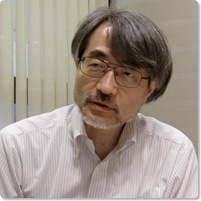
Takashi Morishita
Butoh was born in Japan as a new form of physical expression that overturned the conventional concepts of ‘dance’ and is known widely around the world today. Due to the long-term presence of Butoh artists like Akira Kasai and Ko Murobushi as instructors at the Centre National de Danse Contemporaine Angers (CNDC) and the many workshops held, Butoh has had a larger presence than many Japanese realize as a new form of expression in dance. It was Tatsumi Hijikata who gave birth to the art of Butoh, and 2011 marks the 25th anniversary of his passing. More than half a century has passed since Hijikata created and performed what is considered the first Butoh work in 1959, taking both its inspiration and title from Yukio Mishima’s short novel Kinjiki (Forbidden Colors). During this time, Butoh has not only been continued as a dance form in Japan but continues to have a profound influence on artists around the world, known by its original Japanese name. Today, the “Tatsumi Hijikata Archive” of the Research Center for the Arts and Arts Administration, Keio University in Tokyo has collected a definitive archive of materials on Hijikata and his art. This archive was established in 1998 with a core of the materials from the collection of Hijikata’s studio, the Asbestos Studio.
“Tatsumi Hijikata Archive” of the Research Center for the Arts and Arts Administration, Keio University
http://www.art-c.keio.ac.jp/
Interviewer: Tatsuro Ishii
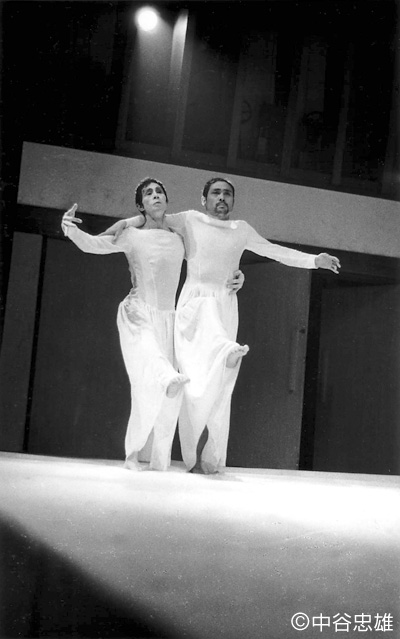
Barairo Dance – A LA MAISON DE M. CIVECAWA
(Duet with Kazuo Ohno)
Photo: Tadao Nakatani
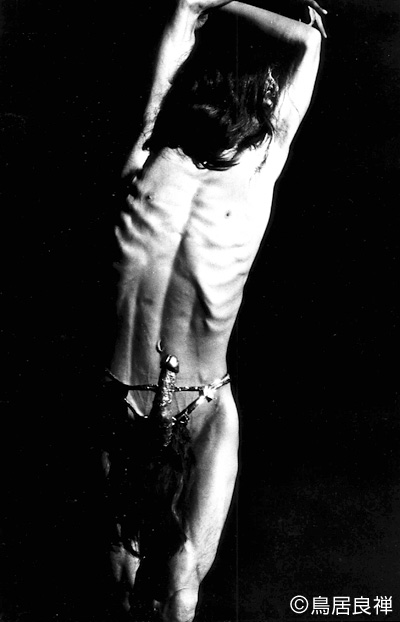
Nikutai no Hanran
(Revolt of the Body)
Photo: Ryozen Torii
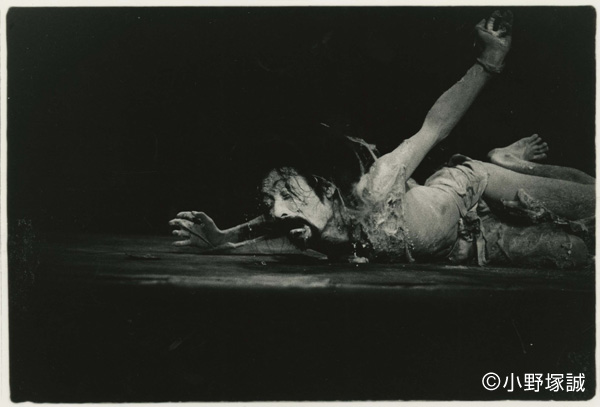
Hoso-tan
(Story of Smallpox)
Photo: Makoto Onoduka
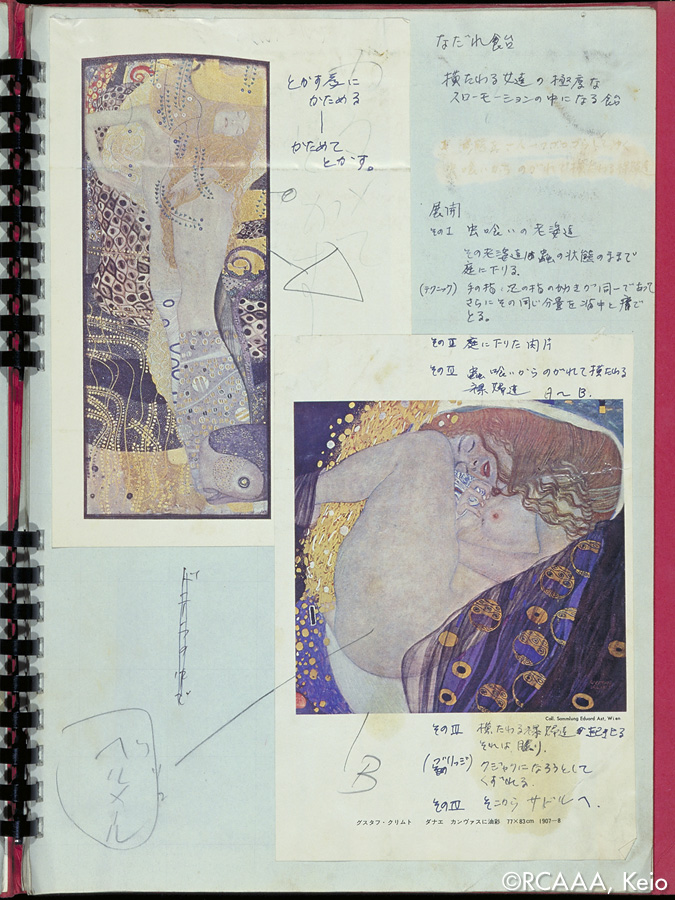
Butoh-fu scores for Nadare-Ame (1972, clipping of Gustav Klimt’s painting)
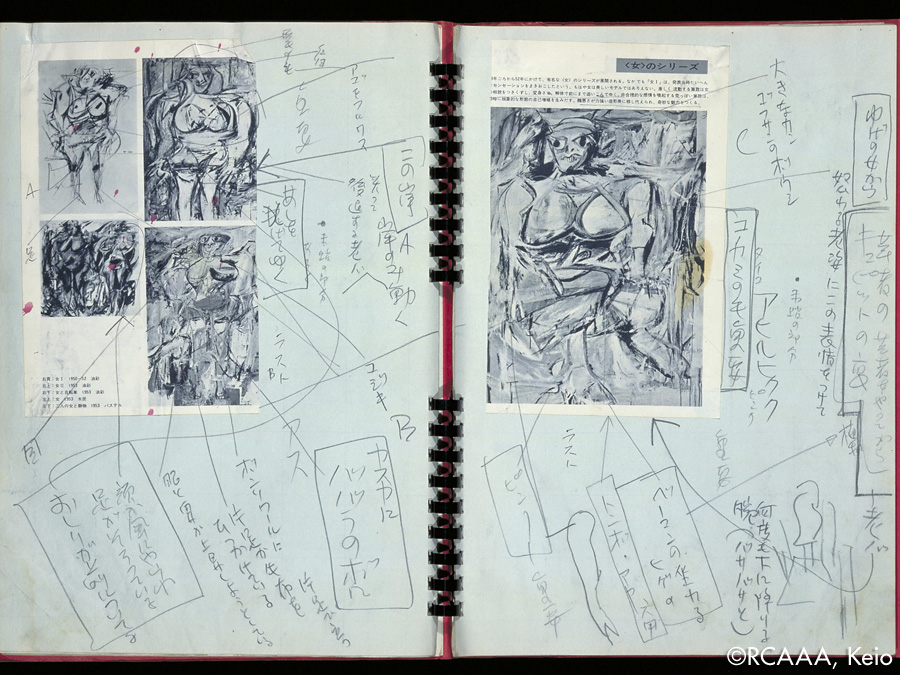
Butoh-fu scores for Nadare-Ame (1972, clipping of Willem de Kooning’s painting)
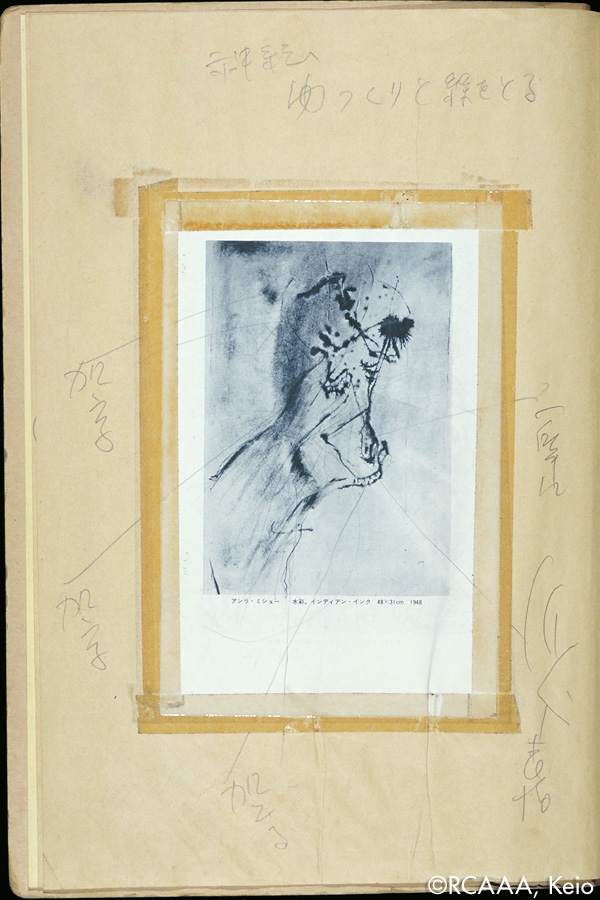
Butoh-fu scores for Shinkei (Clipping of Henri Michaux’s painting)
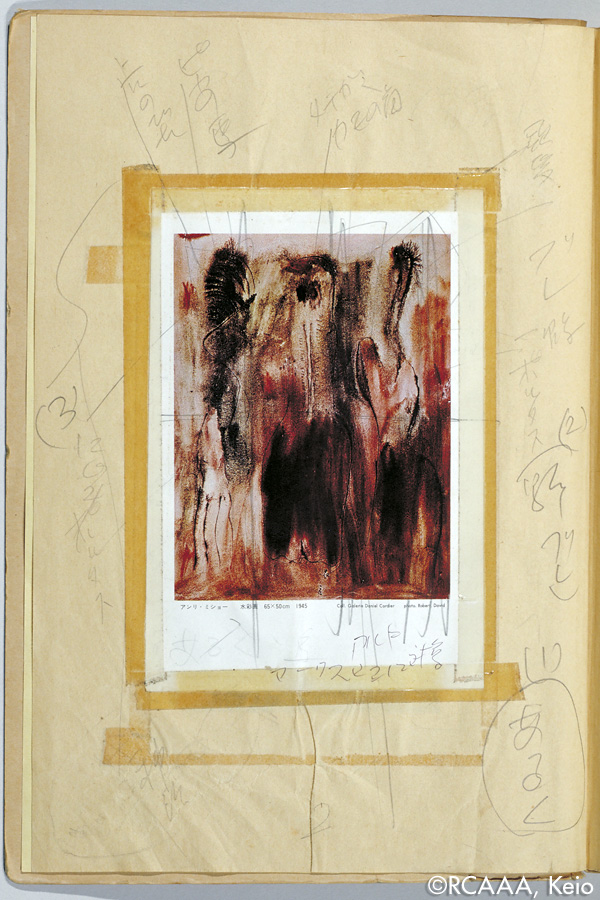
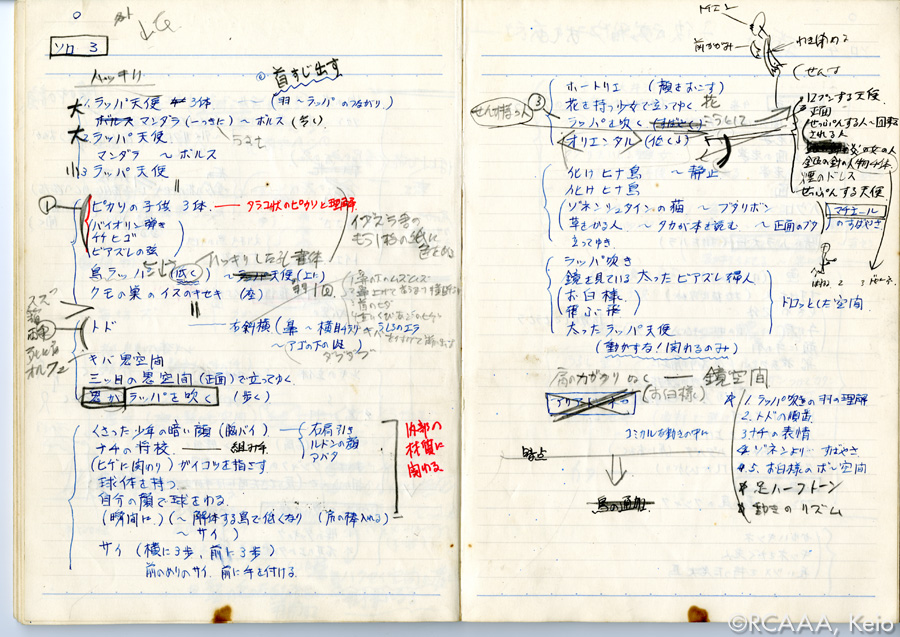
Moe Yamamoto’s Butoh notes for Shomen no Isho (1976, scene of the “Goldfish”)
Related Tags

